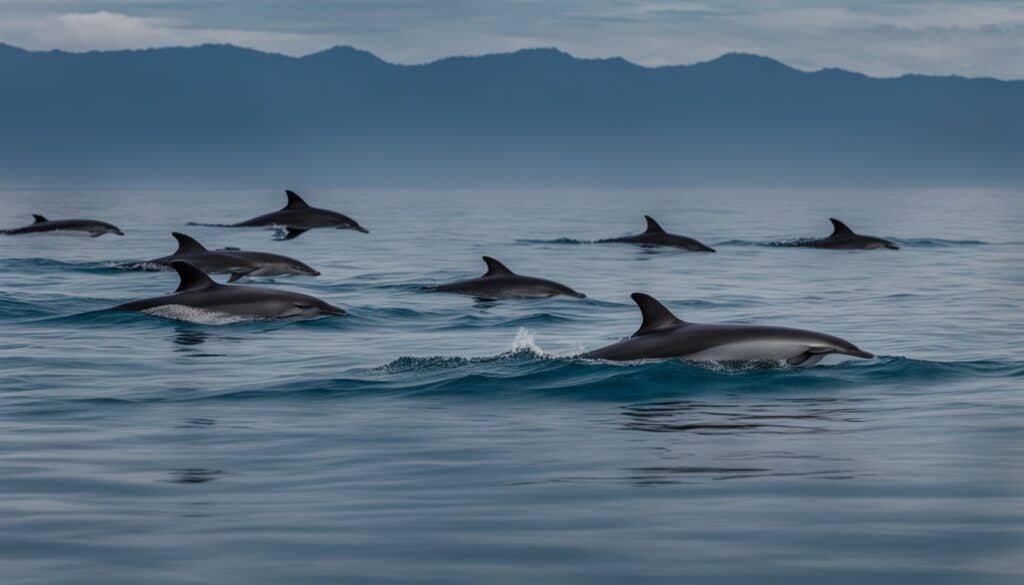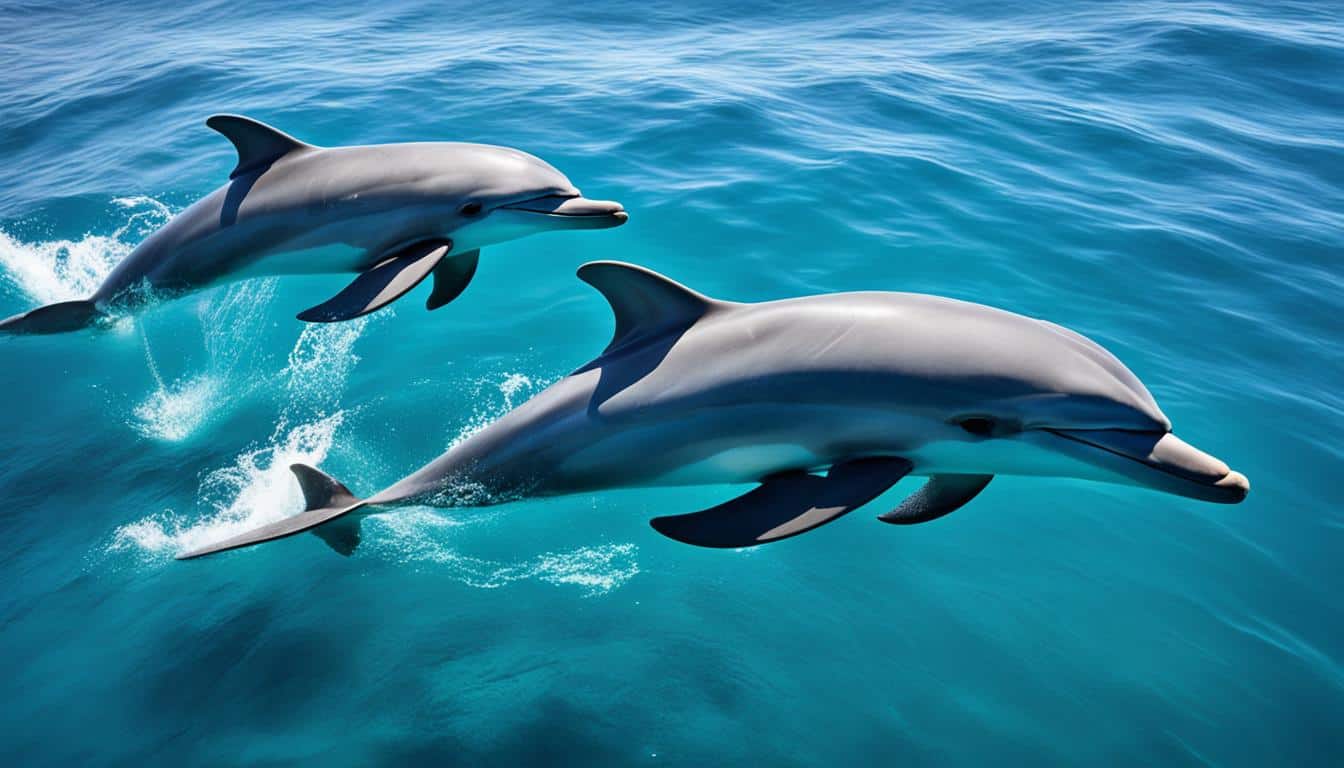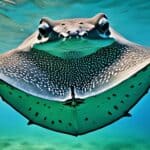Dolphins are amazing creatures that sleep differently than humans. You might ask, how do dolphins sleep? They have special ways of resting that help them survive in the ocean. Dolphins sleep in a way that lets one half of their brain rest while the other stays awake.
This means they can breathe and stay alert for dangers. It’s a clever way for them to rest while still being ready to defend themselves. This unique sleep pattern is crucial for dolphins living in the water.
Unique Sleeping Mechanisms of Dolphins
Dolphins have a special way of sleeping that sets them apart from other mammals. They use a method called unihemispheric slow wave sleep (USWS). This lets them rest while staying alert to their surroundings. They take turns sleeping with one half of their brain, keeping an eye out for dangers in the water.
Unihemispheric Slow Wave Sleep (USWS)
When dolphins sleep, one half of their brain is awake while the other half rests. This way, they can keep an eye open while the other half gets some shut-eye. They usually rest for about two hours per side, balancing sleep with staying alert to their environment. This helps them stay safe while they rest.
Conscious Breathing During Sleep
Dolphins don’t breathe automatically when they sleep like humans do. They have to make an effort to come up for air. This means they stay a bit awake even when they’re resting. Being able to breathe on their own while sleeping shows how smart and adaptable dolphins are, helping them survive in the water.
How do dolphins sleep?
Dolphins have unique ways of sleeping that let them rest while staying alert. They have special adaptations that help them use less energy when they sleep. This keeps them ready for threats and changes in their environment.
Hydrodynamic Adaptations for Rest
Dolphins can adjust to their underwater world when they sleep. They can rest near the surface or go to the ocean floor. While they sleep, they might not move at all or move slowly, which saves energy.
This way of sleeping is key to their survival. Dolphins sleep in ways that let them quickly react to dangers. They use special positions and movements to rest and stay alert. These traits show how smart and adaptable dolphins are in the water.
Dolphin Sleep Patterns and Behavior
Dolphins have unique sleep patterns that show how they adapt to life in the sea. One interesting behavior is called “logging.” They float still at the surface, looking like a driftwood log. This usually happens at night, when they can rest deeply.
Logging: Resting at the Surface
Logging helps dolphins save energy and stay alert to dangers. They can rest while still watching for threats. This way, they relax safely and efficiently, showing how they rest in the ocean.
Social Sleeping in Pods
Dolphins also sleep together in groups, known as pods. Some sleep while others keep watch for predators. This teamwork shows their social nature and helps keep everyone safe while they rest. It makes sleeping easier for the group and supports their sleep patterns.
Marine Mammal Resting Techniques
Marine mammals, like dolphins, have unique ways to rest in the water. These methods help them save energy and stay safe. They are very interesting to learn about.
Vertical and Horizontal Resting Positions
Dolphins rest in both vertical and horizontal positions. When they swim upright, they can quickly respond to threats. This way, they use less energy and stay alert.
On the other hand, dolphins can also rest horizontally, floating on the surface. This position is more relaxing but makes them less aware of dangers. These different ways of resting help dolphins survive in the ocean.
Echelon Swimming Among Mothers and Calves
Echelon swimming is another way dolphins rest. Mothers and their calves swim together in a line. This helps the calves stay afloat and keeps the mothers close while they rest.
This method is efficient for energy use. The calf is safe and secure, letting the mother rest. These behaviors are key for dolphins to survive in the sea.

Impact of Environment on Dolphin Sleep
Environmental factors greatly affect dolphin sleep habits. Dolphins are smart and stay alert for threats even when resting. This alertness affects how well they can sleep.
Awareness of Predators and Obstacles
Dolphins can watch their surroundings, especially for sharks. When they sleep, they can still be partly awake. This lets them quickly respond to danger. It’s key for their safety and rest.
This shows how important ocean conditions are for dolphin sleep. It helps us understand how dolphins sleep based on their environment.
Effects of Ocean Conditions on Sleeping Habits
The ocean’s state affects how long and well dolphins sleep. Calm waters let them rest longer. But rough seas make them stay alert, breaking their sleep.
This shows dolphins need to adapt to sleep while staying ready for challenges. It’s important for their rest and survival.
Dolphin Sleep Research Insights
Recent studies have shown how dolphins sleep underwater. They use EEG technology to find out dolphins sleep about 33.4% of the day. This shows how they manage to rest while living in the sea.
Dolphins sleep in a special way. They let one half of their brain sleep while the other stays awake. This helps them stay alert for dangers and find their way in the water.
These studies are not just interesting facts. They help us understand how marine mammals survive in tough places. By learning more about how dolphins sleep, scientists can help protect and care for these smart animals.
| Aspect of Dolphin Sleep | Details |
|---|---|
| Average Sleep Duration | 33.4% of the day |
| Type of Sleep | Unihemispheric slow-wave sleep |
| Benefits | Awareness of surroundings, predator avoidance |
| Research Methods | EEG readings and behavioral observations |
Conclusion
Dolphins have amazing ways to sleep that help them thrive in the water. They sleep with only half their brain at a time and can breathe on their own. These skills are key to their sleep in the sea.
Looking into dolphin sleep shows how they survive. They rest while staying alert thanks to social habits and smart sleep methods. This shows how they balance rest and alertness in the ocean.
Learning about dolphin sleep helps us understand more about marine life. It shows how these smart animals adapt and stay strong in a tough environment. It’s all about being ready to act and rest at the same time.
FAQ
How do dolphins sleep?
Dolphins sleep in a special way called unihemispheric sleep. This means one half of their brain rests while the other half stays awake. This is important for their survival in the ocean.
What is unihemispheric slow wave sleep (USWS)?
Unihemispheric slow wave sleep (USWS) lets dolphins rest one half of their brain at a time. The other half stays awake. This way, they can breathe and stay alert for dangers.
How do dolphins manage conscious breathing during sleep?
Dolphins must come up for air while they sleep, unlike humans. Their sleep lets them stay alert enough to breathe. This complex process is crucial for their survival.
What hydrodynamic adaptations do dolphins have for resting?
Dolphins can rest near the surface or float still, a behavior called logging. This saves energy. These ways of resting help them stay alert to their surroundings.
What are the different sleep patterns exhibited by dolphins?
Dolphins sleep in different ways, like floating at the surface or sleeping in groups. Some dolphins keep watch while others rest. This shows their social nature.
What resting techniques do marine mammals use?
Marine mammals, like dolphins, use special ways to rest. They rest in vertical or horizontal positions to save energy. Mothers also swim with their babies to help them float while they rest.
How do environmental factors impact dolphin sleep?
Things like predators and ocean changes affect how dolphins sleep. Dolphins must stay alert in dangerous places. This can change how much and how well they sleep.
What insights have recent dolphin sleep studies provided?
New studies show dolphins sleep about 33.4% of the day. These studies help us understand their sleep habits, how their brains work, and how they adapt to the water.







